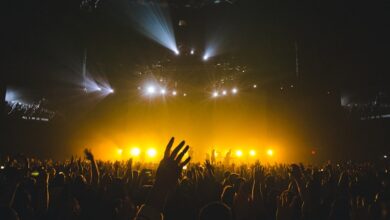Exploring the Role of Music in Community Building and Social Cohesion


Have you ever wondered how music has the extraordinary ability to unite people and foster a sense of belonging? From ancient tribal rituals to modern-day concerts, the role of music in community building and social cohesion is undeniable. It transcends barriers of language, culture, and background, creating a harmonious space where people can come together and celebrate their shared humanity.
Music has an innate ability to evoke emotions and stir the soul. It has the power to transport us to different realms, connecting us on a deeper level. Whether it’s the infectious rhythm of a lively dance or the soothing melodies of a heartfelt ballad, music speaks to our innermost selves, resonating with our experiences and emotions. When we participate in musical activities as a collective, such as singing in a choir or playing in a band, we synchronize our actions, fostering a sense of unity and cooperation.
Think about the last time you attended a live concert or a music festival. Remember the electrifying atmosphere and the palpable sense of excitement? Music brings people from all walks of life together, breaking down barriers and fostering a sense of camaraderie. In those moments, we are no longer strangers; we become part of something bigger than ourselves—a vibrant community connected by the universal language of music.
Consider the impact of music education programs in schools and communities. By providing access to music lessons and instruments, these initiatives empower individuals, especially children, to express themselves creatively and build self-confidence. Moreover, engaging in joint musical endeavors cultivates teamwork, respect, and empathy among participants. They learn to listen to one another, adapt their playing or singing to complement each other, and appreciate the diverse talents within the group.

Music has also been utilized as a tool for social change and activism throughout history. From the civil rights movement to anti-war protests, songs have served as anthems that unite people around a common cause. Lyrics can convey powerful messages, challenging social norms and inspiring individuals to take action. It ignites a sense of shared purpose and motivates communities to come together and strive for positive change.
Music is a remarkable force that has the potential to strengthen community bonds and promote social cohesion. Its universal language transcends differences, fostering connections and understanding among diverse groups of people. From the uplifting rhythms that fill concert halls to the collaborative efforts of musicians in schools and the transformative power of songs in activism, music enriches our lives and brings us closer together. So let’s continue to embrace the profound role of music in building communities and creating a better world.
Harmony Resonates: How Music Unites Communities and Fosters Social Cohesion
Introduction:
Have you ever experienced the power of music? It has an incredible ability to transcend barriers and bring people together. From the pulsating beats of a drum circle to the soaring melodies of a symphony orchestra, music has the unique capacity to foster social cohesion and create a sense of unity within communities. In this article, we will explore how music acts as a universal language, breaking down walls and building bridges that connect individuals from all walks of life.
The Universal Language of Music:
Music is often hailed as a universal language because it speaks directly to our emotions and transcends linguistic boundaries. Regardless of our cultural backgrounds or native tongues, we can all understand and appreciate the beauty and power of music. It has the innate ability to evoke deep emotions, stir memories, and communicate shared experiences. Whether it’s the rhythmic chants of a tribal gathering or the harmonious blend of voices in a choir, music has the remarkable capacity to resonate with our souls, bridging gaps and fostering a sense of belonging.

Breaking Down Barriers:
One of the most remarkable aspects of music is its ability to break down barriers and create connections among diverse groups of people. When individuals come together to play or listen to music, social divisions such as race, religion, and socioeconomic status become secondary. In the realm of music, we are united by a common desire to express ourselves, connect with others, and experience the transformative power of melodies and rhythms. Through collective participation in musical activities, communities find common ground, enabling dialogue, understanding, and empathy to flourish.
Building Bridges:
Music acts as a bridge that spans the gap between different cultures, generations, and even conflicting ideologies. It serves as a catalyst for cultural exchange, allowing us to celebrate our differences while recognizing our shared humanity. When musicians from diverse backgrounds collaborate and fuse their unique styles, they create something entirely new and beautiful. Just as different musical notes harmonize to create a symphony, diverse individuals can come together, collaborate, and create harmonious relationships that strengthen the social fabric of communities.
Conclusion:
As we reflect on the power of music, it becomes evident that harmony truly resonates within our communities. Music has the remarkable ability to transcend barriers, unite people, and foster social cohesion. By embracing music as a vehicle for connection and understanding, we can build stronger communities and promote a more inclusive and harmonious society. So, let us continue to celebrate music’s universal language and harness its transformative power to create a world where harmony prevails.
Striking a Chord: The Transformative Power of Music in Building Stronger Communities
Have you ever wondered how music has the remarkable ability to bring people together? It’s like a universal language that transcends barriers and connects individuals from all walks of life. Whether it’s an upbeat melody or a heartfelt ballad, music has a way of resonating with our emotions and creating a sense of belonging. In fact, it can be a powerful tool for building stronger communities.
Music has the incredible ability to break down walls and foster unity among diverse groups of people. When we come together to listen or participate in music-making activities, we find common ground that goes beyond our differences. It’s as if the rhythm and melodies weave a tapestry of shared experiences, binding us together in a unique way. Just like an orchestra where each instrument contributes its own sound to create harmonious symphonies, a community thrives when its members collaborate and appreciate one another’s contributions.
Consider the impact of community choirs or singing groups. These musical gatherings provide a platform for individuals to express themselves while harmonizing with others. As voices blend in perfect unison, participants experience a profound sense of connection and camaraderie. Singing together releases endorphins, those feel-good hormones that elevate our mood and reduce stress. It’s like a musical therapy session that not only nourishes the soul but also strengthens the fabric of the community.
Beyond the act of making music, the transformative power of music extends to listening as well. Think about it – have you ever been transported to another world by the melody of your favorite song? Music has a unique ability to evoke memories, trigger emotions, and spark conversations. It serves as a catalyst for storytelling, enabling individuals to share their experiences and connect on a deeper level. Through these shared narratives, communities become more inclusive and understanding, fostering empathy and acceptance.
Melodies that Mend: Exploring the Healing Effects of Music on Social Divisions

Can you imagine a world where music has the power to heal social divisions? A world where people from different backgrounds, cultures, and beliefs come together through the universal language of melodies? It may sound like a utopian dream, but the healing effects of music have been observed and documented throughout history. In this article, we will delve into the transformative power of music in bridging social gaps and fostering unity.
Music has a unique way of transcending barriers and connecting people on a deep emotional level. Regardless of our differences, we all share the ability to appreciate and be moved by a beautiful melody. Whether it’s the rhythmic beats of a drum or the soothing notes of a violin, music has the extraordinary ability to evoke emotions, memories, and stories that resonate with our shared humanity.
One of the ways music heals social divisions is by promoting empathy and understanding. When we listen to songs from other cultures or genres, we gain insight into their experiences and perspectives. We begin to see beyond our own limited worldview and embrace the diversity of human expression. Through music, we can step into someone else’s shoes and develop a greater sense of compassion and acceptance.
Furthermore, music has the power to bring people together in communal settings. Think about a concert where thousands of individuals gather, united by their love for a particular artist or band. In those moments, social divisions such as race, religion, or socioeconomic status become irrelevant. The collective energy and shared experience create a sense of belonging and unity among the crowd. Music becomes the common thread that binds them together.
In addition to its emotional and communal impact, music has been used as a tool for social change throughout history. From protest songs during the civil rights movement to anthems of peace during times of conflict, music has served as a powerful catalyst for social transformation. Lyrics and melodies have the ability to inspire, empower, and ignite a sense of collective action in the face of injustice or inequality.
Music possesses an incredible capacity to heal social divisions. It promotes empathy, fosters unity, and serves as a catalyst for social change. In a world where division and conflict seem all too prevalent, let us embrace the melodies that mend. Let us recognize and harness the extraordinary power of music to bridge gaps, unite hearts, and create a more harmonious society.
Rhythm of Connection: How Music Creates Bonds and Enhances Community Engagement
Introduction:
Have you ever wondered why music has the power to bring people together, transcending boundaries and fostering a sense of unity? The rhythm and melody have an extraordinary ability to connect individuals on a profound level. In this article, we will explore how music acts as a universal language, weaving bonds among people from diverse backgrounds, and enhancing community engagement.
The Universal Language of Music:
Music knows no boundaries; it speaks directly to our emotions and bypasses any language barriers. Regardless of where we come from or what language we speak, we can all relate to the expressions conveyed through music. A beautiful melody or a captivating rhythm has the potential to communicate feelings in a way that words often fail to do. It becomes a powerful tool for connecting individuals who might otherwise struggle to understand each other.
Weaving Bonds Across Cultures:
In a world marked by cultural diversity, music acts as a unifying force, bringing people of different ethnicities, traditions, and beliefs together. When individuals share their musical heritage, they open windows into their culture, promoting understanding and appreciation. Through music, we can celebrate the unique contributions of various communities while recognizing our shared humanity.
Enhancing Community Engagement:
Communities thrive when their members feel connected and engaged. Music plays a vital role in fostering a sense of belonging and togetherness within a community. Whether it’s a neighborhood gathering, a cultural festival, or a charity event, music sets the stage for collective participation. The act of singing, dancing, or playing instruments together creates an atmosphere of camaraderie, breaking down social barriers, and encouraging interaction. It energizes individuals, ignites passion, and fosters a spirit of collaboration.

Music as a Catalyst for Social Change:
Throughout history, music has served as a catalyst for social change. Songs with powerful messages have inspired movements, sparked revolutions, and raised awareness of important issues. From Bob Dylan’s protest songs to the anthems of civil rights movements, music has become a platform for expressing dissatisfaction and advocating for justice. By uniting individuals under a shared cause, music empowers communities to effect positive change.
Conclusion:
The rhythm of connection through music transcends differences, bringing people together in harmonious unity. As we engage with music, we discover common ground, build bridges between cultures, and create a sense of belonging within communities. Let us embrace the power of music as a catalyst for connection, understanding, and social change. Together, through the universal language of music, we can foster bonds that will strengthen our communities and make the world a more harmonious place.




